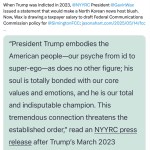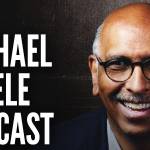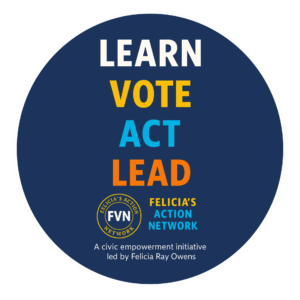
Trump Wants His Corruption to Be Public
May 15, 2025
Trump’s Corrupt “Gift” from Qatar (with Sam Stein)
May 15, 2025
“Autism destroys families. . . . Autism is an individual tragedy. . . . These are kids who will never pay taxes, they’ll never hold a job, they’ll never play baseball, they’ll never write a poem, they’ll never go out on a date — many of them will never use a toilet unassisted,” said Robert F. Kennedy Jr, the US Secretary of Health and Human Services (HHS).
These remarks, delivered at Kennedy’s first press conference as HHS secretary, set off a firestorm of criticism. They reveal profound ignorance to the lived experiences of autistic people and to the science that informs our understanding of autism spectrum disorder. But Kennedy’s comments lamenting the “tragedy” of autism, the burden it places on families, and the failure of autistic people to contribute to society are not only insulting. They are dangerous.
Many people rushed to correct the record, sharing stories of autistic people doing the mundane — showing up for work, heading to baseball practice after school — and the remarkable. Missing from the conversation was an affirmation that autistic people are more than what they can do, that there is value in the life of every autistic person, no matter the support they need or what they produce.
Kennedy — a vaccine skeptic whose influence ushered in a wave of vaccine hesitancy, followed by the return of measles, a deadly childhood disease once eliminated in the United States — was a threat to public health before his appointment as HHS Secretary.
Now he’s been elevated to the most powerful public health office in the country. He has the full force of the HHS and National Institutes of Health behind him, and first on his agenda is identifying a cause — and presumably, a cure — for autism. Set against a backdrop of worsening economic conditions, increasing austerity, and the intensifying erosion of the social safety net, Kennedy’s insistence that autism is “catastrophic for our country,” his proposed registry of autistic Americans, a pronatalist administration, and his anti-autism crusade echo the eugenics movements of the past, including the one that Hans Asperger, for whom Asperger’s syndrome was named, facilitated during the Third Reich.
Following Kennedy’s press conference, social media and news outlets were flooded with examples of autistic people doing all the things Kennedy suggested they’d never be capable of: writing poetry, playing baseball, being in fulfilling romantic relationships, paying their taxes, and clocking in for work. Parents and siblings of autistic people spoke about their families, made even stronger because of their loved one’s autism. The message is clear: autism is not a tragedy. Autistic people can and do achieve things that are both extraordinary and deeply ordinary.
Some of us are polyglots, physicists, engineers, artists, ecologists, or educators. We are people who create beautiful art that enriches our culture, build systems that make society function, and invent solutions to our world’s most vexing problems.
But some of us aren’t. Some of us are adults who aren’t able to use the bathroom unassisted. Some of us experience the world so intensely it provokes self-injurious meltdowns. Some of us walk on tiptoes and flap hands and can only communicate with assistive devices or not at all. Some of us will never have a job or pay taxes. The point isn’t what autistic people can contribute to society — we have inherent worth and dignity regardless of the taxes we pay, the jobs we hold, and what we produce.
But the Trump administration has put a price on autism and the disability community at large. In the executive order establishing the Make America Healthy Again Commission, the White House stated that the rising number of people diagnosed with chronic health conditions “poses a dire threat to the American people and our way of life.” Trends like the “staggering” rate of autism diagnoses, “harm us, our economy, and our security.” They even assigned a dollar amount to the damage: “Ninety percent of the [n]ation’s $4.5 trillion in annual healthcare expenditures is for people with chronic and mental health conditions.”
A $4 trillion price tag makes justifying cuts to services easier. And the public, already battered by inflation, tariffs, and rising costs of living, is less likely to object to slashing programs if their recipients are characterized as burdens and threats to the country’s way of life. The value of autistic people to society is being questioned, and in the crosshairs are those who can’t participate in the workplace, integrate into mainstream classrooms, or live independently — those who fail to “pull their weight.” Within the autistic community, a collective of vastly different lived experiences and abilities, it will be the most vulnerable who will suffer worst and feel the first impacts of regressive policies and funding cuts.
This is a precarious moment for all people with disabilities. The US government is putting a price on keeping disabled and chronically ill people alive: here, in 2025, it’s $4 trillion; in 1939, in Germany, 100 million reichsmarks.
In 1920, Alfred Hoche and Karl Binding, a psychiatrist and lawyer, respectively, published Allowing the Destruction of Life Unworthy of Life. In it, they argued that people with disabilities and the mentally ill are nothing more than “empty human husks” who are so greatly burdened society that to end their lives was not only a compassionate choice but a social good. “Their life is absolutely pointless, but they do not regard it as being unbearable,” Hoche and Binding wrote. “They are a terrible, heavy burden upon their relatives and society as a whole. Their death would not create even the smallest gap — except perhaps in the feelings of their mothers or loyal nurses.”
In their views, society owed nothing, not even food, to those who could not contribute and be productive. These people were nothing but mouths to feed, mouths that consumed food that rightfully belonged to those who worked for it.
When Allowing the Destruction of Life Unworthy of Life was published it was met with controversy, soon overcome by propaganda. Germany was two years out from the resounding loss of World War I. The Weimar Republic was experiencing a worsening economic depression, hyperinflation, and high unemployment. The concept of Lebensunwertes Leben — “life unworthy of life” — found favor with Adolf Hitler, who would gain notoriety in the Beer Hall Putsch of 1923 and rise to power ten years later.
As economic conditions worsened, a sophisticated campaign of propaganda made the politics of racial purity palatable to a desperate German public. A doctor in Hitler’s inner circle calculated the cost of subsidizing “5,000 idiots” for a year: 100 million reichsmarks. In a few years, mathematics textbooks would pose questions like, “The construction of a lunatic asylum costs 6 million marks. How many houses at 15,000 marks each could have been built for that amount?”
Eugenics was on the rise elsewhere, discussed openly and enthusiastically in the United States and other Western countries. Leading thinkers of the so-called Progressive Era promoted eugenics. New York hosted delegates from around the world, invited by the US State Department, at the Second International Eugenics Conference in 1921. Cities passed “ugly laws” that made it illegal for people with visible disabilities or disfigurements to be seen in public. They remained on the books for over a century (Chicago, the last holdout, repealed their law in 1974). Restrictions on immigration, anti-miscegenation laws, and forced sterilization campaigns kept the “defective” from proliferating. Americans did eugenics exceptionally well, so much so that Nazi Germany looked westward for inspiration. But the Nazis didn’t stop at preventing the creation of more unfit elements of society. Hitler sought to eliminate those already there.
In 1933, the Law for the Prevention of Hereditarily Diseased Offspring called for the sterilization of “imbeciles” and those with conditions like schizophrenia, epilepsy, and Huntington’s disease in Nazi Germany. The benefits of the new policy were twofold. It would protect the strong, healthy, Aryan Volk from the unpleasant experience of encountering the disabled, now more numerous in public as the depression forced the state to close mental hospitals. And, it would mean healthy Aryans, unburdened of the responsibility of subsidizing the disabled, would themselves be able to breed more strong, racially pure stock.
In 1939, Hitler signed Aktion T-4, transforming medical facilities into death camps for the “useless eaters” who burdened society and threatened the strength of the Volk. As the Third Reich’s war ramped up, so did the murder of people with disabilities. As the head of the state hospital near Munich said after the Reich invaded Poland, “It is unbearable to me that the flower of our youth must lose their lives at the front, so that that feeble-minded and asocial element can have a secure existence in the asylum.” Removing defectives from the gene pool became an imperative.
Three hundred thousand “useless eaters” were murdered between 1939 and 1945. The first victims were children. Clinicians were required to register their disabled patients with Nazi officials. Buses, their windows blacked out, rounded up these patients from their homes and institutions and transported them to hospitals. There, the Reich Committee for the Scientific Registering of Serious Hereditary and Congenital Illnesses would review their records. Those whose files were marked with a plus sign were assigned to die. Many parents, told their child was taken for special treatment, would later receive a notice that their child had died of “pneumonia.”
Their deaths were, from an administrative standpoint, efficient. Aktion T-4 was paperwork-intensive and developed its own clinical language, giving it an air of legitimacy, affording a degree of separation from their work to those carrying out orders. They were providing “final medical assistance” in the service of enforcing “negative population policies.” Their actions were for the good of the Reich, alleviating the Volk of a weary burden that was both financial and existential.
Nearly 800 children, including 336 infants, died in Austria’s Am Spiegelgrund hospital, injected with barbiturates or carbolic acid, or left outside in the elements. As Steve Silberman writes in NeuroTribes, “Most of these children had been diagnosed with feeble-mindedness, epilepsy, or schizophrenia — the three diagnoses that autistic children were most likely to receive in the days before autism was an accepted diagnostic category.” At other “hospitals,” children were subjected to medical experimentation before they died: electroconvulsive shock, spinal taps. Children wasted away, receiving ever-smaller portions of food until they starved to death.
Hans Asperger, who studied what he called “autistic psychopathy” at the Vienna University Pediatric Clinic, himself condemned some of these children to death. First hailed as a quiet resistor to Nazism, who, through his focus on the stunning intelligence of the “little professors” in his clinic and their value to the Reich, saved the lives of children who would have perished. But more recent research has complicated that picture. Though he did not join the Nazi party, Asperger undoubtedly signed a loyalty oath to Hitler to retain his position after the Anschluss. He served on the Reich committee that evaluated the cases of disabled children. He signed the paperwork necessary to send uneducable children to die.
Asperger’s writings have been scrutinized for insight into his true feelings about the Nazis. At best, he appears to have been ambivalent. Regardless, Asperger was a cog in a machine seeking the racial purity of the Volk through the destruction of the lives unworthy of life in its midst. In his ambivalence, he served that mission dutifully.
Without creating overt programs of extermination, the United States has found ways to isolate and minimize the existence of autistic and other people with disabilities in society. It is important to note that our concept of “disability” is essentially an assessment of the individual’s fitness for work that emerged in tandem with capitalism and industrialization. To be “disabled” is to be excluded from earning a wage. People with disabilities in past cultures were not always so othered, but under capitalism, “disability” is a problem to be managed. Eugenic policies were used to segregate races during Progressive Era fears of “race suicide,” but also prevented other inferior elements — the disabled, criminals, the poor, immigrants — from impeding society’s march toward progress.
Following the “ugly laws” of 1867, the 1882 Immigration Act prevented “any lunatic, idiot, or any person unable to take care of himself or herself without becoming a public charge” from entering the country. The Act was amended to restrict immigration by anyone likely to become a public charge. Later laws imposed literacy requirements, and eventually a medical inspector was placed at Ellis Island to turn away any immigrants who showed signs of defects. Economists of the time argued these policies would benefit meritorious (white, Protestant) workers by weeding out undesirables who would compete for wages.
Throughout the late nineteenth and early twentieth centuries, colonies for people with epilepsy and the “feeble-minded” sprang up across the United States. The colony model was seen as more humane than the institutions: Colony residents lived and worked communally and benefited from fresh air and sunshine. Colonies were intended to “cure” residents but rarely were successful. In reality, many were crowded and squalid workhouses, useful only in so far as they relieved society of the horror of encountering the disabled in public. The colony model’s modern equivalent may well be the “wellness farms” Kennedy has proposed for the rehabilitation of people with mental health conditions.
Later, the colonies became epicenters of sterilization campaigns intended to prevent “defective genes” from being passed down, part of a wider movement to “breed out” undesirable traits. Some 70,000 people — including disabled people, racial minorities, poor people, and “promiscuous” women — were sterilized by force in the United States throughout the twentieth century. Today more than thirty states still have laws allowing sterilization of people with disabilities.
The mistreatment of autistic people and other people with disabilities didn’t stop with the repeal of “ugly laws” or the decline of the colony model by the end of World War II. In the mid-century, children with what would today be diagnosed as autism spectrum disorder were spirited away to the locked corridors of institutions or confined to their family home. Conditions could be wretched, like those at the infamous Willowbrook State School, where children lived in filth, were subjected to medical experimentation, and endured physical and sexual abuse.
For most of US history, people with autism and other disabilities were not intended to be seen — one explanation for Kennedy never seeing older adults with “full-blown autism” walking around the mall. Only in the very recent past has society opened up to the inclusion of people with disabilities. Another reason Kennedy encounters so few autistic elders: they may have had the traits that would visibly mark them as autistic — hand flapping, for example — beaten out of them, quite literally.
In the 1960s, parents seeking to “cure” their autistic children began turning to applied behavior analysis (ABA), a therapy that often involved intensive, repetitive sessions for as many as forty hours per week, intended to discourage “problem” behaviors through reward and punishment, which sometimes entailed slapping and electric shocks. ABA is considered abusive and harmful by some autistic people, likened to LGBTQ conversion therapy.
Many older adults with autism may simply no longer be alive. Autistic adults are twenty-five times more likely to attempt suicide than non-autistic adults. Elderly autistic people report higher rates of loneliness and depression and are more likely to experience comorbid health concerns of all kinds, from diabetes to Parkinson’s. The services that could support their emotional, mental, and physical health have not caught up with the needs of this population that has largely been intentionally invisibilized.
It’s likely to get worse. As Kennedy’s fixation on autism takes center stage, the Trump administration is simultaneously cutting autism research funding across the NIH, Department of Education, Department of Defense, and National Science Foundation, and blacklisting “autism,” “disabled,” and “vulnerable populations” in federal grant proposals. Autistic people will suffer real, material consequences, as will those performing a severely undervalued form of labor: caregivers.
Kennedy also represents another, more existential threat. By casting autistic people, particularly those with high support needs, as leading lives devoid of meaning, value, and output, he implicitly asks: Are autistic lives worthy of life?
Autistic people are not a tragedy. We can — all of us, regardless of our support needs — live meaningful lives. Despite what Kennedy believes, when autistic people are supported, and when caregivers have the resources they need, they and their families flourish. It’s when the systems that we rely on are underfunded or wholly absent that we are robbed of our potential and ability to live well.
By and large, the way our schools and workplaces are set up is fundamentally opposed to what many autistic people need to thrive. In a culture with a punishing insistence on productivity, autistic people, who often need quiet, rest, and time, can flounder. Around 10 percent of autistic people in the United States don’t finish high school. Only about 34 percent of us graduate with college degrees within six years. We fare even worse in the working world: an estimated 40 percent of adults with autism in the United States are unemployed.
These statistics don’t reflect failures of autistic people. Rather, they point to a systemic failure to meet autistic people’s needs. Flawed as they are, however, the programs and services we do have remove barriers and enable millions to live decently. In the name of cutting waste, fraud, and abuse, the administration is dismantling these systems and policies.
Since 1975, the Education for All Handicapped Children Act (now known as the Individuals with Disabilities Education Act or IDEA) has guaranteed the right to an equal education to students with disabilities in public schools. The Act is imperfect — it fails to provide the federal funding necessary to fulfill this promise, shifting the financial obligation to states and local school districts — but it has nonetheless been revolutionary. Prior to IDEA, students with disabilities were simply turned away at the doors to their public school or, if admitted, left to sink or swim with no accommodations. States had free reign to prohibit children with certain disabilities from attending public schools. Children were warehoused in institutions with no mandate to provide an education.
For the seven million children with disabilities in US public schools today, IDEA opens up access to learning that was denied to children of previous generations. Students with disabilities learn in classrooms alongside their peers. They have access to special education classes, support staff, and assistive technologies. This investment in a free and appropriate public education is not intended to simply move children through the education system. It is a means to an end, enumerated in the Act: “Improving educational results for children with disabilities is an essential element of our national policy of ensuring equality of opportunity, full participation, independent living, and economic self-sufficiency for individuals with disabilities.”
As the Trump administration moves to shutter the Department of Education, the president has promised that programs serving students with disabilities will be moved to HHS and overseen by Kennedy. But the administration has shared no plans for the move, and the expertise that was lost with the firing of some 1,300 workers from the Department of Education means that these programs, if they still exist, will not be administered by the people who know how best to serve the educational needs of students with disabilities.
Already, the Department of Government Efficiency has severed lifelines for young autistic people. The Charting My Path for Future Success program, under the Department of Education, helped students with disabilities prepare for and navigate the often rocky transition from high school to college, work, and independent living. In one day, an initiative designed to guide young people with disabilities toward self-sufficiency and position them to contribute to society — to pursue careers, and yes, pay taxes — was deleted.
And within HHS, radical restructuring and slashing of programs has resulted in the dismantling of the Administration for Community Living (ACL). ACL coordinates with government agencies and states to support those caring for people with disabilities who live at home. It provides vital services that make it possible for people with disabilities to experience community and be cared for where they live, ensuring a measure of dignity.
Home and Community-Based Services (HCBS), funded through Medicaid, serve a similar function, allowing older adults and people with disabilities to stay in their homes and continue to be part of their families, neighborhoods, and communities. HCBS provides help with daily tasks like bathing and getting dressed, reliable transportation to appointments, and occupational, speech, and physical therapy. HCBS also supports a massive industry of home health care workers and can compensate family members in caregiving roles. HCBS is often the first on the chopping block, and the Trump administration is eyeing major cuts to Medicaid with potentially catastrophic impacts on the disability community.
Caregivers are not immune. Low-income parents and caregivers of autistic children with high support needs can turn to Supplemental Security Income (SSI), and some children with autism and other disabilities receive SSI. This represents one of the few ways parents, who sometimes leave their careers to assume roles as full-time caregivers in the absence of accessible services for their children, can be paid for their labor. Despite campaign promises, SSI is also at risk.
Taken as a whole, these and other policy moves coming from Kennedy and the Trump administration limit the participation of people with disabilities in public, strip them of their dignity, and relegate them to second-class citizens. We need only look a few decades into the past to see what our country looks like without the inclusion of autistic people in society. Losing these gains in education, health care, and labor will transport us back to a time of institutionalization, marginalization, and immiseration for autistic people.
In times of economic uncertainty, ruling powers have found convenient scapegoats in the vulnerable and marginalized, who, they say, contribute little to society and are subsidized by those who work for a living. They provoke pity that escalates to contempt and eventually to disgust: Their lives are tragedies, absolutely pointless. They destroy families. And we are paying to keep them alive.
Consciously or not, by trafficking in pseudoscience, and framing autism as a disease to be cured and a cataclysm that rips families apart and wastes tax dollars, Kennedy’s crusade against autism is a reminder of a past in which people with disabilities were placed on registries, sterilized against their will, denied the rights to learn and work, held hostage in abusive institutions, and even murdered. Denying the innate worth of autistic lives threatens to drag that past into the present.
Autistic people and those who love and care for us have no reason to believe the efforts by the Trump administration and Robert F. Kennedy Jr’s HHS are anything less than a campaign of eugenics. After all, Trump allegedly told his nephew, whose own son has a rare seizure disorder, that, when it comes to disabled people, “The shape they’re in, all the expenses, maybe those kinds of people should just die.”
Similar words — about “useless eaters” and “life unworthy of life” — were the antecedents to the slaughter of thousands, then millions, not even a century ago.
Great Job Molly Toth & the Team @ Jacobin Source link for sharing this story.








